![]()
|
Index | Pottery | Pottery manufacturers | W
T Copeland (and Sons) |
|
[Josiah
Spode] |
[Copeland
& Garrett] |
[W.
T. Copeland (& Sons)] |
[Spode
Ltd] |
Location and period of operation:
|
W T
Copeland (and Sons) |
Stoke |
1847
|
1970 |
| China,
Parian and Earthenware
manufacturer at the Spode
Works, Stoke, Stoke-on-Trent,
England. W. T. Copeland & Sons was a prominent British pottery company founded in the
early 19th century. It originated from the partnership between Josiah Spode
II and William Copeland. After Josiah Spode's death in 1827 William Taylor Copeland took over the firm, and by 1847, the company officially became
W. T. Copeland & Sons.
|
Previously: Copeland & Garrett
Subsequently: Spode Ltd
Selected
by the Committee for the Staffordshire Potteries
to exhibit at the Paris Universal Exhibition of 1855

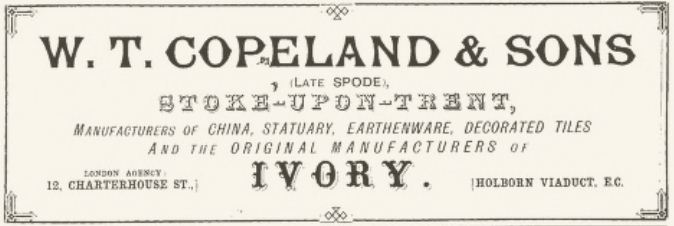
W T Copeland & Sons
(late Spode)
Stoke-upon-Trent
Manufacturers of China, Statuary, Earthenware, Decorated Tiles
and the original manufacturers of
Ivory
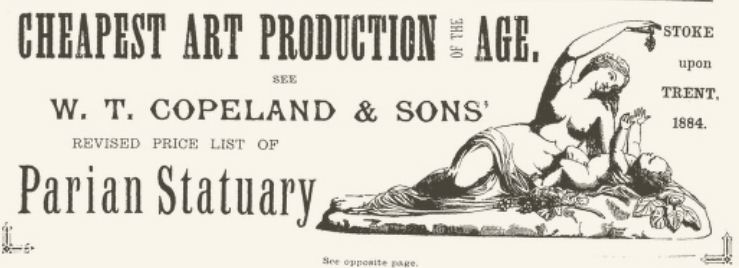
W T Copeland & Sons
Parian Statuary
Pottery Gazette, January 1885
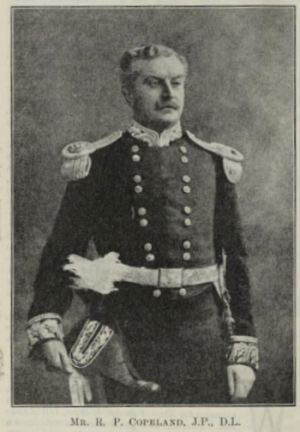
Richard Pirie Copeland head of W. T. Copeland & Sons |
Obituary It is with deep regret that we record the death on Monday, March 3, of Mr. Richard Pirie Copeland J.P.. D.L., of Kibblestone Hall, Stone, Staffs., head of the famous firm of W. T. Copeland & Sons, Stoke- on-Trent. The deceased gentleman, who was in his seventy-second year, had been ailing for some eight months prior to his death, but towards the end of February he became much weaker, and expired between 1 and 2 o’clock on the date already mentioned, from exhaustion. The late Mr. R. P. Copeland was born at Leyton, Essex, in the year 1841, and received his education abroad. In 1867, together with his three brothers, he was taken into the firm as a partner. Alderman William Taylor Copeland, of whom he was the fourth and youngest son, died in the following year, and eventually the late Mr. R. P. Copeland became the sole proprietor of the business, and assisted by his sons sought always to uphold the traditions of the old-established and distinguished business to which it was his lot to succeed. The deceased was well known in public life, and highly respected throughout the county. He was appointed a county magistrate in 1876, and occupied the chair of the Stone Bench of magistrates for a long time. He was also at one time a member of the old Stoke Town Council and succeeded the first holder of the office, Alderman William Keary, as Mayor. In 1903 he became High Sheriff of the county. At one time the County Council also claimed his attention, and altogether he did his best to fulfill his civic obligations. Latterly, however, the deceased led a more retired life, but up to within twelve months of his death regularly visited the factory in High- street At 70 years of age the late Mr. Copeland was well and strong, and it was only during the last eight or nine months that his health took a downward turn which quickly laid him aside. The interment took place at Oulton Cemetery on Thursday, March 6, and was deeply impressive. The employees of the factory were represented by a goodly number of foremen and officials, and there were many beautiful floral tributes. The deceased gentleman is succeeded in the business by his sons Mr. Ronald J. Copeland and Mr Gresham Copeland, who were taken into partnership some time ago. The Pottery Gazette - 1st April 1913 |
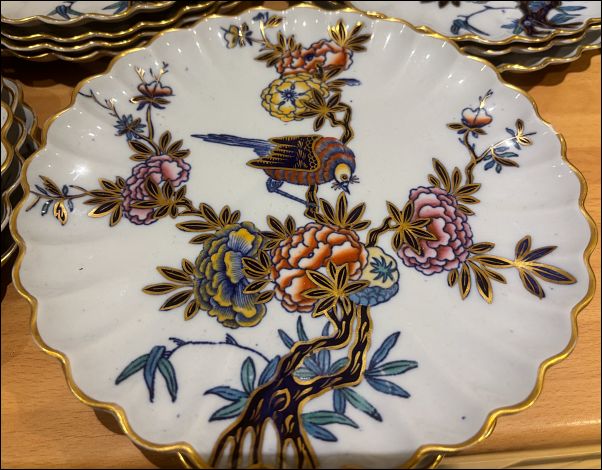 Copeland pattern 1/1293
|
|
c. 1878-1883 pseudo-seal marks, designed to imitate Asian porcelain marks, were used by a number of English potters |
photos courtesy: Aide Davis

carrier by Copeland in a
transferware pattern
|
the
letter B refers to the B recipe of the earthenware - this recipe was
used about 1860 -c. 1895 |
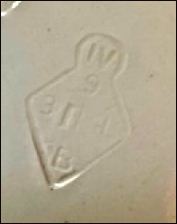 the registration diamond shows that the pattern/design was registered on the 9th October 1882 |
photos courtesy: Donna Gilmore
 bowl in a hand painted pattern this bowl was made in 1893 with a pattern that was introduced in 1882 |
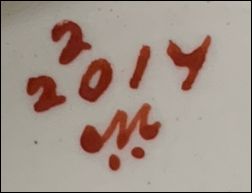 2 / 2017
impressed mark - the 'I' indicates the recipe for the body 93 is the year of manufacture - in this instance it shows that the bowl was made in 1893 |
photos courtesy: Ian Wederell
 desert plate in a printed pattern with hand colouring |
this style of printed mark was probably introduced in 1869
hand painted pattern number - this pattern was first introduced in 1888
impressed mark - the 'B' body was cream coloured desert ware M 90 is a date of manufacture - in this instance it shows that the plate was made in March 1890 The impressed '24' is a workman mark |
photos courtesy: Else Aaro
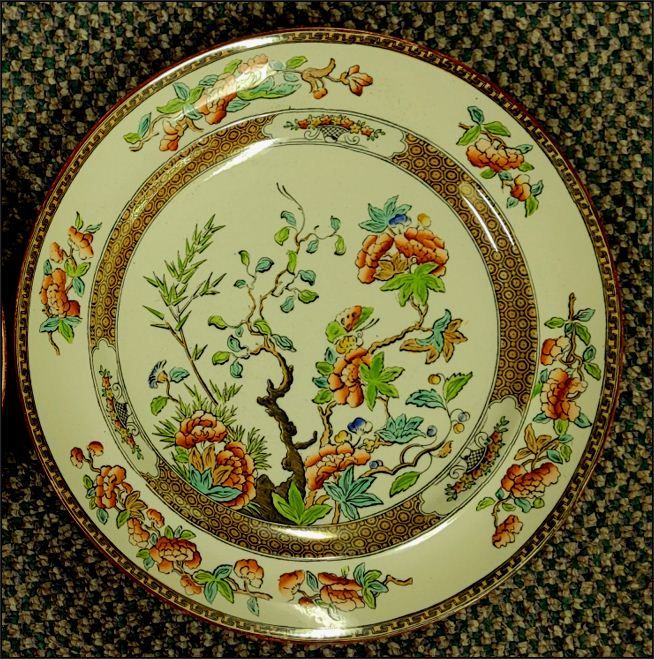 hand painted plate in an 'Oriental' style Typically, on this
style of pattern the flowers are chrysanthemums which |
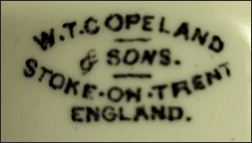 W. T. Copeland & Sons Stoke-on-Trent England mark probably post 1890 |
photos courtesy: Rae Morrell
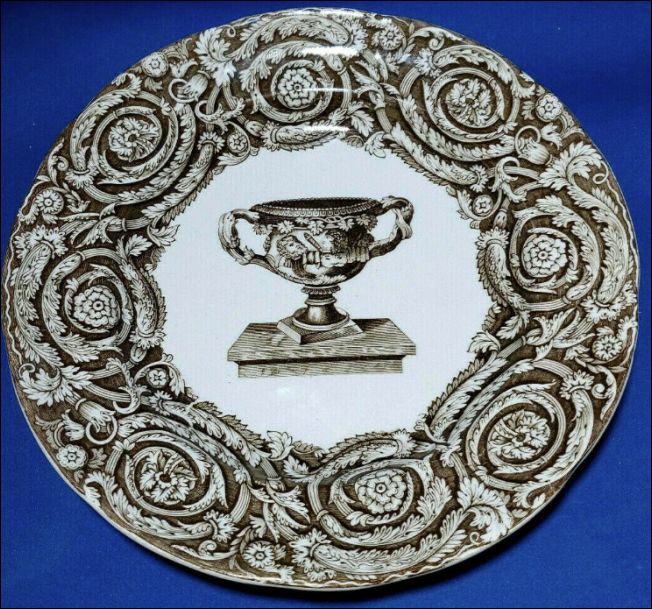
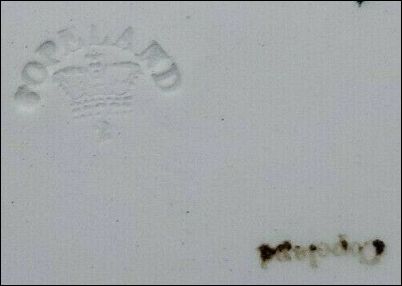
plate in the Warwick Vase
pattern
- see more on the Warwick Vase -
Marks used on ware for identification:
| The name “Spode” and "late Spode" often appears on Copeland-era ware because the Copeland family continued the Spode business, valued its reputation, and used the name as a trademark to maintain continuity, market trust, and pattern identity. |
COPELAND
COPELAND
LATE SPODE
W T COPELAND & SONS
SPODE BONE CHINA
ENGLAND
Frank's Boat
Mark
|
This sailing boat mark was introduced around 1887 and continued to c.1910. "The design seems to be based on pattern number 2/2927 designed by Frank Abraham (1858-c1933), son of Robert Abraham, Art Director." Robert Copeland, Spode & Copeland Marks, p.71 Godden dates the marks c. 1894-1910, however Robert Copeland differentiates between between those without a registration number 180288 (c. 1887-94) and those with the number 180288 (1894-1910). The sailing boat mark with the registration number 180288 and ENGLAND was registered on the 11th September 1894. The registration is for this trade mark and not for the pattern. |
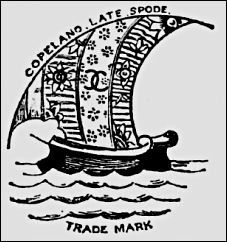 Copeland Late Spode Trade Mark c. 1887-94 note the simple intertwined Cs on the sail
|
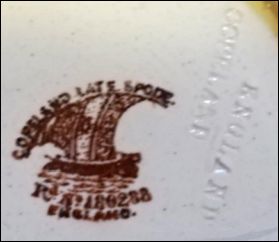 Copeland Late Spode Rd No 180288 England (printed) England |
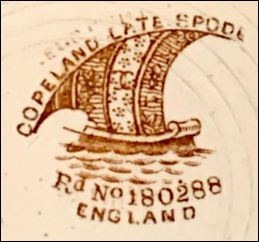 Copeland Late Spode Rd No 180288 England |
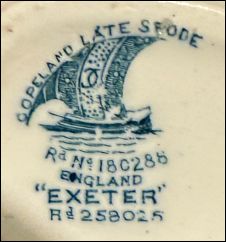 Copeland Late Spode Rd No 180288 England "Exeter" Rd 258025 EXETER is the pattern name it was registered on the 12th July 1895 |
| The
sailing boat mark with the registration number 180288 and ENGLAND was
registered on the 11th September 1894. The registration is for this trade
mark and not for the pattern. Sometimes the pattern name and a pattern registration number is included. |
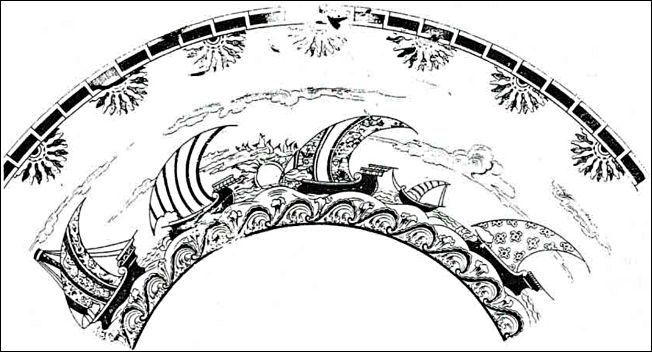
pattern number 2/2927 designed by Frank Abraham
(1858-c1933),
son of Robert Abraham, Art Director
"A section of print pulled
from the copper plate for pattern 2/2927
from which Frank's Boat' marks are derived"
Robert Copeland, Spode & Copeland Marks, p.71
| From 1870 to 1963 Copeland
sometimes used an impressed mark to indicate the month/year of
manufacture.
in this example the impressed letter A above 80 gives a date of April 1880 The letter code for each month are:
|
- click for more -
Questions, comments, contributions? email: Steve Birks
|
Page created 13 February 2022 Updated: 5 October 2025: introduction expanded Last updated: 25 November 2025: explanation of 'Frank's Boat Mark' added. |